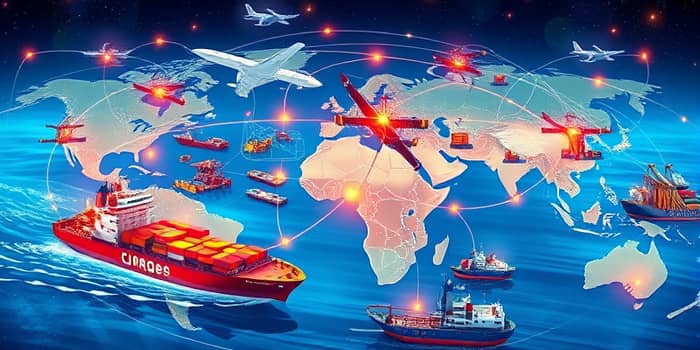
Global supply chains underpin nearly every product and service we consume, connecting raw materials, manufacturing sites, logistics hubs, and end users across continents. As investors seek to navigate post-pandemic recovery, climate pressures, and geopolitical shifts, understanding these networks is critical for identifying risks and opportunities.
In 2025, supply chains are more visible yet more vulnerable than ever. Strikes at major ports, extreme weather events, and trade disputes can instantly ripple through markets, affecting inflation, equity valuations, and sector performance. This article explores the evolution of global supply chains, current trends, operational realities, and practical investment strategies.
A global supply chain is the integrated system that moves goods from raw material extraction through manufacturing, distribution, and finally to end consumers. These interconnected processes often span multiple regions, each adding value but also introducing risk.
Consider a modern smartphone: minerals extracted in Africa, semiconductors fabricated in East Asia, software developed in North America, and final assembly in Southeast Asia before global distribution. Each link relies on stable logistics, skilled labor, and functional infrastructure.
Several forces are redefining supply chain operations and investor outlooks.
Geopolitical friction and trade policy shifts continue to reshape traditional routes. Renewed US-China tensions and protectionist measures prompt firms to diversify suppliers and consider nearshoring options.
Extreme climate events and environmental pressures—from La Niña-driven floods to prolonged droughts—disrupt production and transport. Companies are forced to evaluate location risk and invest in resilient infrastructure.
Technological transformation with AI and big data is making supply chains more transparent. Advanced analytics improve demand forecasting and route optimization, while blockchain pilots aim to enhance traceability and reduce fraud.
Investors must recognize key vulnerabilities and how leading companies mitigate them.
Resilience measures have become central to corporate strategy. Firms reporting higher-than-expected losses are now prioritizing risk management and flexibility over cost cutting.
Leading companies adopt multiple tactics to shore up their networks:
Environmental, social, and governance factors are now inseparable from supply chain decisions. Investors demand transparency on carbon emissions, labor conditions, and ethical sourcing.
Companies are rolling out mandatory supplier surveys on emissions and waste, third-party audits on labor rights, and public reporting on ESG compliance. Those failing to meet standards face consumer backlash and regulatory fines.
Advanced analytics and AI-driven risk models are transforming supply chain management. Real-time tracking, predictive maintenance, and automated decision-making reduce lead times and improve resilience.
Initiatives such as the Global Resilient Supply Initiative (GRSI) aim to identify bottlenecks before they cascade, leveraging shared data and collaborative planning among industry peers.
Supply chain disruptions feed directly into corporate performance and market volatility. Inflationary spikes driven by logistics bottlenecks can erode profit margins, prompting equity sell-offs in manufacturing, logistics, and consumer goods sectors.
Emerging opportunities lie in companies offering logistics optimization, cybersecurity services, and ESG auditing. Insurance and hedging instruments tailored to supply chain risks are gaining traction, providing investors with novel ways to manage exposure.
In a world of rising uncertainties, investors who grasp the nuances of global supply chains—and the strategies companies employ to fortify them—will be better positioned to weather volatility and seize growth opportunities. By focusing on transparency, diversification, and innovative risk management, portfolios can become more resilient and aligned with long-term value creation.
References













